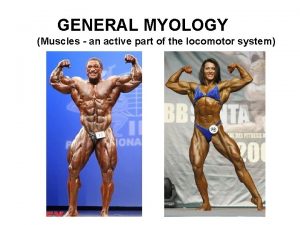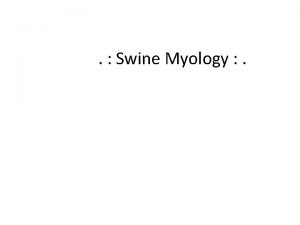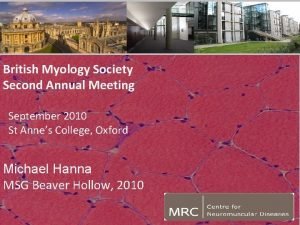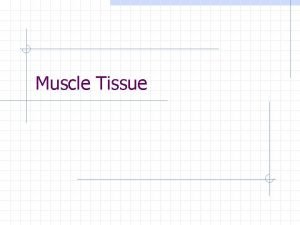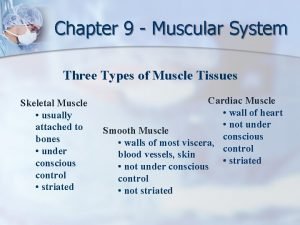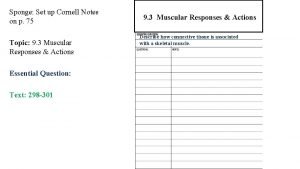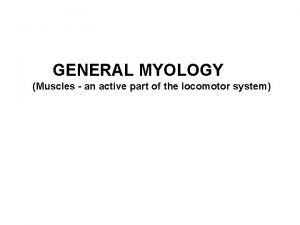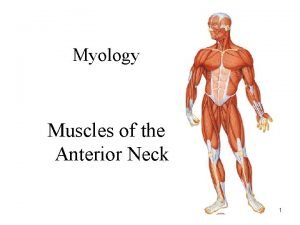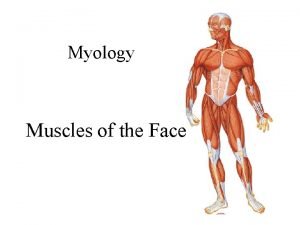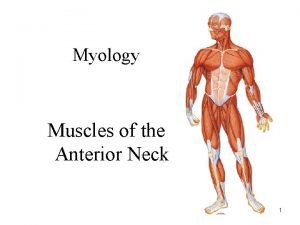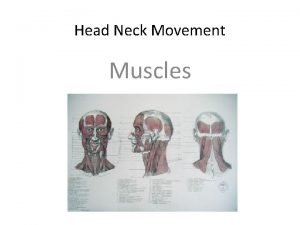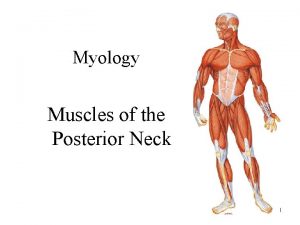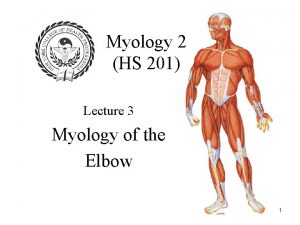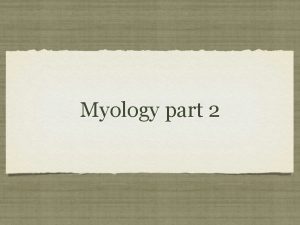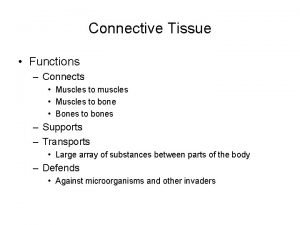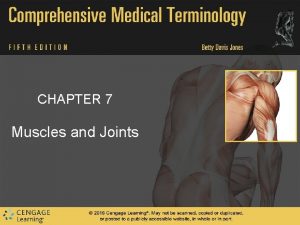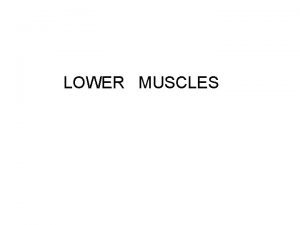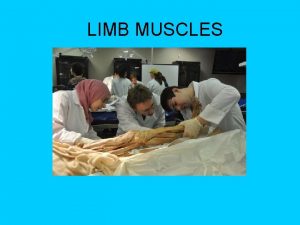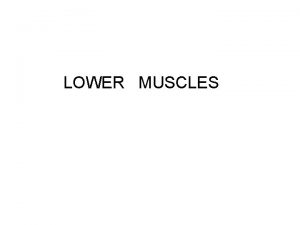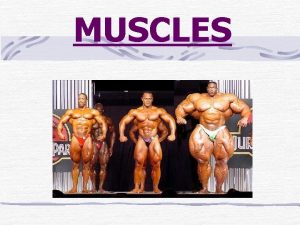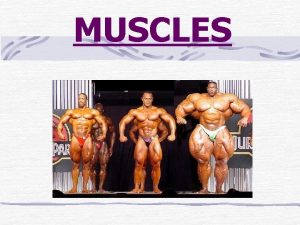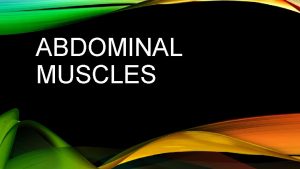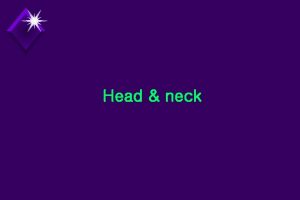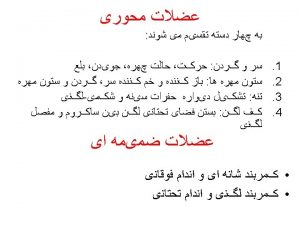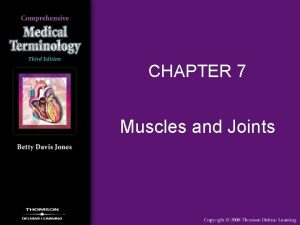GENERAL MYOLOGY Muscles an active part of the


























- Slides: 26

GENERAL MYOLOGY (Muscles - an active part of the locomotor system)

General function of muscles * produce movement in sites of skeletal junctions * change shapes of various body cavities and openings * give information about the body position in 3 D space * important role during thermoregulation * help to blood and lymph circulation * verbal and non verbal comunication * about 600 muscles (♂ 35%, ♀ 32% of weigth) * logistic system (supports respiration, digestion…)

On the basis of structure and physiological characteristics we distinguish: 1) Striated (skeleton) muscles – musculi sceleti (form muscles of limbs, work under control of our will, easy fatigued, spend a lot of energy, produce heat) + skin muscles (musculi cutanei) 2) Cardiac muscles (myocardium) 3) Non-striated visceral (smooth) muscles – form an integral part of some hollow organs and cavities - work without our will, without fatigue).

The main of the mechanical function of muscle fibers is shortening - contraction (movement).

Common structure of muscle Origo (origin) Caput (head) Fascia (cover) Venter (belly) Tendo, aponeurosis Insertio (insertion) Cauda (tail)

Structure of muscle ORIGO fascia fibrous membrane – fascia – separates the muscles (or groups) from adjacent structures Vessels and nerves enter into muscle by its hilus (rich ramification) tendo INSERTIO (insertion) Tendons are attached to the bones by Sharpey´s fibres

Auxiliary facilities of muscles 1. Fasciae – allow to move one muscle against the other 2. Bursae synoviales (synovial bursae) – protect muscle tendons against friction 3. Tendo, aponeurosis=tendon of flat muscles 4. Trochleae musculares (muscular trochleae) – fibrous loops keeping tendon to a bone, permit change of direction of muscle pulling 5. Ossa sesamoidea (sesamoid bones) – at the places of pressure 6. Vaginae tendinum (tendon sheats)

Auxiliary facilities – vaginae tendinum and vaginae synoviales (tendon and synovial sheaths) A space along tendons, closed, increasing sliding capacity of tendons Fibrous layer = stratum synoviale= stratum fibrosum (synovial layer) ext. and int. layer with mesotenonium for penetration of vessels into tendon) (Osteofibrous canal) Purulent inflammation can spread here

Division of muscles according to the shape • long type (predominantly limb muscles) • flat type of muscles (abdominal wall muscles) • short type of muscles (circumarticular muscles) • Composed: • biceps, begins with two heads (triceps, quadriceps) • digastric muscle – musculus digastricus (multi-bellied muscle) • orbicular muscles, mm. orbiculares (various types of sphincters) • unipennate muscles or multipennate muscles

Division of muscles according to the function synergists x antagonists flexors x extensors Example: biceps of brachium x triceps of brachium abductors x adductors Example: abductor pollicis brevis x adductor pollicis dilatators x sfincters Example: dilatator pupillae x sphincter pupillae

Division of muscles according to regions of the body Muscles of the head Muscles of the neck Muscles of the thorax Muscles of the abdomen Muscles of the diaphragma pelvis Muscles of the back Muscles of the upper limb Muscles of the lower limb

SPECIAL MYOLOGY Description of the muscle: 1. name of muscle 2. group (a part of body) Origo - origin Insertio - insertion Functio – function/action Innervatio - innervation

SPECIAL MYOLOGY Mm. capitis (Muscles of the head) 1) MUSCULI MASTICATORII (MASTICATORY MUSCLES) Innervation - n. trigeminus = V. cranial nerve 2) MUSCULI FACIALES (MUSCLES of FACIAL EXPRESSION) Innervation - n. facialis = VII. cranial nerve NO FASCIA! – skin muscles

Mm. faciales (mimic muscles) (facial nerve – n. VII. ) Muscles of the scalp Muscles of the orbit region Muscles of the nasal region Muscles of the mouth region Their contraction causes shift of the skin (folds or wrinkles) – it is the basis of the facial expression. They have no fascias!

Muscles of the neck (mm. colli) Superficial layer m. platysma m. sternocleidomastoideus mm. suprahyoidei (depression of mandible) mm. infrahyoidei - mainly fixation of os hyoideum (hyoid bone) Deep layer - mainly flexion of the neck (and head) mm. scaleni mm. prae- and intervertebrales

Musculi thoracis, abdominis et dorsi (Muscles of the chest, abdomen and back)

Musculi thoracis (thoracic muscles) 1. Thoracohumeral muscles mainly ventral flexion and abduction of the upper limb Musculus pectoralis major Musculus pectoralis minor Musculus subclavius Musculus serratus anterior 2. True (original) thoracic muscles for respiratory movements Musculi intercostales externi, interni et intimi Musculus transversus thoracis 3. Diaphragma main muscle for inspiration

Musculi abdominis (abdominal muscles) antagonists of the dorsal muscles, regulate the volume of the abdominal cavity

Musculi abdominis (muscles of the abdomen) antagonists of the dorsal muscles, regulate the volume of the abdominal cavity Ventral group musculus rectus abdomis (+ its sheat=vagina mm. recti abdominis) musculus pyramidalis Lateral group musculus obliquus externus abdominis musculus obliquus internus abdominis musculus transversus abdominis musculus cremaster Dorsal group musculus quadratus lumborum Canalis inguinalis (inguinal canal)!!!

Musculi dorsi (muscles of the back) I. Extrinsic muscles of the back II. Intrinsic muscles of the back (located deeper, innervation by dorsal rami of spinal nerves) III. Short muscles of the back Ad I. Extrinsic muscles of the back A) Mm. spinohumerales (spinohumeral group) movements of the upper limb B) Mm. spinocostales (spinocostal group) help respiratory movements

I. EXTRINSIC BACK MUSCLES A. Mm. spinohumerales (spinohumeral group) 1. m. trapezius 2. m. latissimus dorsi 3. m. levator scapulae 4. m. rhomboideus minor 5. m. rhomboideus major

B) Spinocostal group of muscles help respiratory movements 1. m. serratus posterior superior 2. m. serratus posterior inferior

Ad II. Intrinsic muscles of the back mainly extensors of the back and the head, innervation rami dorsales of spinal nerves 1) Spinotransversal system (m. splenius capitis and cervicis) 2) Sacrospinal system (m. erector spinae, longissimus and iliocostalis) 3) Spinospinal system (m. spinalis thoracis) 4) Transversospinal system (m. semispinalis capitis and cervicis)

Ad III. Short muscles of the back Mm. nuchae profundi a) m. rectus capitis posterior minor (lesser) b) m. rectus capitis posterior major (greater) c) m. obliquus capitis superior d) m. obliquus capitis inferior Trigonum suboccipitale (bordered by b, c, d) Content: a. vertebralis a. cervicalis profunda n. suboccipitalis dorsal arch of the atlas 1 2

Fasciae of dorsal muscles Fascia dorsi superficialis Fascia nuchae Fascia thoracolumbalis (actually aponeurosis of m. latissimus dorsi – its lamina superficialis) Aponeurosis lumbalis (lamina profunda of fascia thoracolumbalis, separates m. quadratus lumborum from m. erector spinae)

Used pictures come from: Moore, K. L. (1992): Clinical oriented anatomy. Third edition. Williams&Wilkins, A Waverly Company. Gilroy, A. M. et all. (2009): Atlas of Anatomy. Thieme New York, Stuttgart. Putz, R. (2008): Atlas of Human Anatomy Sobotta. Elsevier Books. Platzer, W. , Kahle, W. , Leonhardt H. (1992): Locomotor system. Georg Thieme Verlag, Stuttgart, New York, 4 th edition. Čihák, R. (1987): Anatomie 1. Avicenum, Zdravotnické nakladatelství.
 Division of muscles
Division of muscles Musculos
Musculos Muscle
Muscle British myology society
British myology society Study of myology
Study of myology Sarcromeres
Sarcromeres Crash course muscles part 2
Crash course muscles part 2 Boolean operators
Boolean operators Active transport
Active transport Primary active transport vs secondary active transport
Primary active transport vs secondary active transport General active clause coverage
General active clause coverage Hát kết hợp bộ gõ cơ thể
Hát kết hợp bộ gõ cơ thể Bổ thể
Bổ thể Tỉ lệ cơ thể trẻ em
Tỉ lệ cơ thể trẻ em Chó sói
Chó sói Chụp phim tư thế worms-breton
Chụp phim tư thế worms-breton Alleluia hat len nguoi oi
Alleluia hat len nguoi oi Các môn thể thao bắt đầu bằng tiếng đua
Các môn thể thao bắt đầu bằng tiếng đua Thế nào là hệ số cao nhất
Thế nào là hệ số cao nhất Các châu lục và đại dương trên thế giới
Các châu lục và đại dương trên thế giới Cong thức tính động năng
Cong thức tính động năng Trời xanh đây là của chúng ta thể thơ
Trời xanh đây là của chúng ta thể thơ Cách giải mật thư tọa độ
Cách giải mật thư tọa độ 101012 bằng
101012 bằng độ dài liên kết
độ dài liên kết Các châu lục và đại dương trên thế giới
Các châu lục và đại dương trên thế giới
